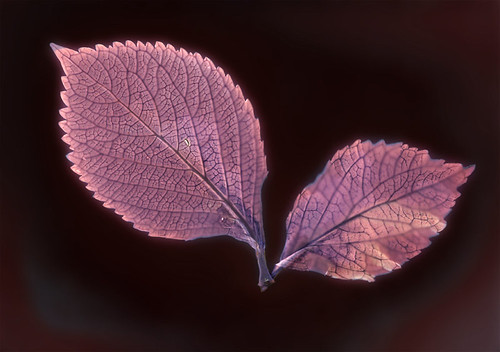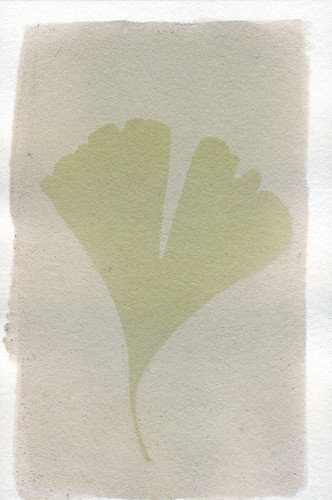I got around to grinding up some blackberries for a new batch of dye. This time, I didn't boil the blackberries, I just blender'd them straight out of the freezer. The boiling seemed to alter the dye's color and properties last time I tried it, so this time I skipped it in an attempt to replicate early successes with blackberry dye.
There was enough of the blackberry puree to split in half: one batch is about 2 parts blackberry to one part rubbing alcohol, the other is the inverse. The blackberry-heavy solution produced expected colors: deep blue-violets that are standing up pretty well to light. I expect long exposure times on those tests.
An alcohol-heavy solution, however, proved surprising. The dye is green, as you can see in the test to the left. Much like the alcohol-heavy batches of sandalwood and turmeric dyes, it reacted much faster to light. A three day exposure produced the example seen here. I'll be trying another for five days fairly soon, just to see if I can get some better contrast.
The blackberry-heavy solutions are still exposing.
Just an artist talking to spiders about alternative photographic processes, cyanotypes, bones, leather, anthotypes, lumen prints and how to mix them all together. Updates weekly, for the glory of Thor.
Tuesday, July 24, 2012
Monday, July 9, 2012
Alcohol Makes Things Better! Sometimes.
 |
| Test #2, Sandalwood. |
These anthotypes were all printed using a much, much greater amount of alcohol than normal. Up till now, I've simply poured a small amount of the powder or what-have-you into a bowl and added just enough alcohol to make the mixture liquid and paintable. This time, I added a buttload of alcohol to the powder in a mason jar, attempting to reach the saturation point instead of heavily over-saturating the mixture. Why? Because I was tired of wasting pigment when the alcohol evaporated off and left me with a dust-covered sheet of paper.
The results so far:
Test #1: Mixture of turmeric and sandalwood. This is the most disappointing of the tests. It may be due to being pulled early, but when I checked it after two days, the field had bleached almost totally away. Problem being, the image itself isn't very visible either. May be the result of the turmeric's characteristic eye-burning-yellow color, when hue-shifted in Photoshop, the image is much more visible, but still not the best.
Test #2: Pure sandalwood, an extremely successful result. Three day exposure gave me a faintly visible pale orange field and a moderately bright image. A 10% bump in the darkness levels with Photoshop got me a nice, dramatic image with a pleasant color. Much better than the burnt-orange-red of high-concentration sandalwood which is almost as hard to see and enjoy as pure turmeric. The high levels of alcohol really shine with sandalwood, it seems.
Test #3: Another pure sandalwood. Virtually identical results as with Test #2, but this one has a darker spot in the center of it. I sat the paper on top of a water bottle to dry, and apparently the cap of the water bottle left a darker area for some reason. Somewhat annoyed. Image integrity very nice, though.
Test #4: Pure turmeric with high alcohol. Not a bad image result, though as with most turmeric images, it benefits from a hue-shift towards orange. The hue-shift makes the image stand out more and reduces the burn on your retinas from staring at the collected essence of the color Yellow. Boring composition makes me hate it, though.
Still waiting on Tests #5 and 6. Planning to give them two more days of exposure.
Test #5 is a boiled blackberry dye, with increased alcohol content to prevent spoilage of the berry juice. The juice at this point is nearly a year old and should probably be thrown out, but the aged juice has a very different color profile than fresh, so I'm hanging onto it. Smells funny.
Test #6 is a double-coated mixture, one layer of boiled blackberry, another of sandalwood. The resulting field color is a reddish-orange instead of the pure orange of sandalwood or the dull violet of boiled blackberry. The leaves used in this anthotype (virginia creeper) have begun to desiccate and shrink. Not happy about that, because it'll give me fuzzy edges on the image. Waiting to see final results before declaring total hatred, though.
EDIT: Ah-hah! I forgot one! There's another test currently in the works. I had a square of heavy linen soaking in boiled madder-root dye. Instead of following all the proper madder-root procedures, I just ground up the roots and tossed them into a pot of boiling water for a few hours, and collected my pretty red water. The linen soaked in it for ~24 hours and is now exposing. Should be ready in another week. I like to give fabric anthotypes a long, long exposure time.
Labels:
alternative processes,
anthotype,
dyes
Thursday, July 5, 2012
New I-lumen-ation!
 |
| Test #1, Crepe Myrtle |
So far, in both my tests, the Polycontrast has produced a brown-red background with violet-maroon images, VERY pretty. One print, left out in light after exposure, has darkened to a blue-violet in the image, with an almost black field.
 |
| Test #2, Hydrangea |
My scanner isn't doing a very good job of capturing these lumens acurately. I may need to buy a new one; there's some kind of horrible, streaky residue that seems to be between the two sheets of glass that make up the scan-plate. I've cleaned both sides of the scan-plate, but the residue remains the same. The scanner hasn't got any problems capturing my cyanovellums or anthotypes, the residue only shows up when scanning the large, blank backgrounds of the lumen prints. It's very distressing. I may need to start imaging them with a camera.
Labels:
alternative processes,
lumen prints,
papers
It's Been A Long Time
 |
| Test #4, most successful test! |
 |
| Test #1 |
- No color shifts, but the bleaching turned the dark blue a mottled cyan-green, with large patched bleached almost fully away. The original image retained its blue color, but was rendered visible where previously it had been almost hidden.
- The 'field' of the image turned a brilliant orange, and the image itself bleached fully out, leaving semi-translucent vellum without any coloration at all.
- The 'field' turned orange as with the previous test, but the image itself retained a blue-gray coloration, a very nice contrast.
- Results identical to #3
I haven't figured out what causes the difference between 1, 2 and 3/4. Oddly, 3 and 4 were bleached the longest, each one soaking for at least 8 hours. I would have expected them to leave no trace of blue at all, but they were the only ones to hold the blue color. Very odd.
 |
| Test #3 |
To make SuperTea! I brewed 8 family-sized bags of Wal-mart brand Black Tea in 2 cups of water for 5 minutes in the microwave and let the tea steep for two hours. I then squeezed the bags to get any extra liquid out of them. The SuperTea had evaporated down to about 16 oz of liquid by this point.
 |
| Test #1: post-borax and post-super tea |
I allowed Test #1 to soak in the SuperTea! for about two hours. The vellum stained heavily, but the image redeveloped about as expected. It's now a very dark blue-black, with the image a more mild tan. No reddish color shift as experienced with cyanotypes that have this process applied when printed on paper.
I've got lots more work ahead with my cyanovellums, but at the moment most of my frames are taken up with six new Anthotypes that'll be cooking for the next week! So excited to see the results!
Labels:
alternative processes,
bleaching,
cyanotype,
parchment,
toning
Subscribe to:
Posts (Atom)
